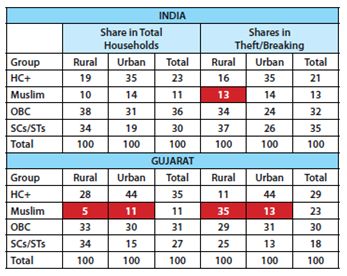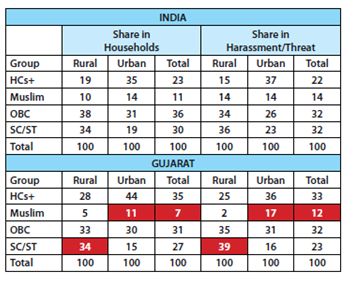By TwoCircles.net staff reporter,
New Delhi: “Poverty amongst the urban Muslims is eight times (800%) more than high-caste Hindus, about 50% more than the Hindu-OBCs and the SCs/STs. Note that over 60% of all Gujarati Muslims live in urban areas and they are most deprived social group in Gujarat. On the other hand rural poverty amongst the Muslims is two times (200%) more than high caste Hindus,’ according to a study by New Delhi-based Centre for Research and Debates in Development Policy (CRDDP).
The report of the study which was released recently is prepared by Dr. Abusaleh Shariff, Executive Director (Designate), US-India Policy Institute, Washington DC and President Centre for Research and Debates in Development Policy (CRDDP), New Delhi and Mr. B. L. Joshi, Chief Executive Officer, CRDDP, New Delhi.

Quotes from the study:
Gujarat growth story is a four-decade old story:
“Gujarat has been occupying 6th or 7th positions most of the last four decade excepting mid-1996 when it was at the 4th position. For the year 2007-08 and in terms of current prices, Gujarat had an income of Rs. 45,773, but Haryana with an annual per capita income of Rs. 59,008 tops the list followed by Punjab, Maharashtra and Kerala.”
“Overall the economic status of Gujarat has been stable and relatively on the higher side at least since last four decades. Thus the Gujarat growth story measured in terms of macro economic indicator is not new; rather it is an old one.”
A hungry state:
“Gujarat surprisingly emerges as a State with high levels of hunger , while simultaneously boasting high per capita income and consistent income stability. Disturbingly Gujarat’s hunger levels are high alongside Orissa and Bihar, with only Jharkhand, Chhattisgarh and Madhya Pradesh having higher hunger levels.”
“Incomes are more evenly spread in Uttar Pradesh, Tamil Nadu and West Bengal. Uttar Pradesh in fact fares a notch above even Tamil Nadu and West Bengal in having lower hunger; but Gujarat is much above all these states in having relatively higher incidence of hunger. Further Rajasthan has also recorded lower levels of hunger compared to Gujarat and this appears to be due to pro-poor state policies. Therefore, this analysis gives credence to the fact that Gujarat is a state where the rich-poor disparities are far greater relatively speaking.”
Poverty:
“On the other hand Gujarat has recorded relatively lower level of human development ranking compared with its poverty ranking – while in latter 2000s it tops at 6th level in income, but is places one level lower in poverty (that is higher poverty relative to income) but ranked 9th in HDI, far too low which is unexpected.”
“Further, one notice that the relative ranking of Gujarat in incidence of poverty and human development has declined between the mid 1990s and latter part of 2000s.”
“When the Mahatma Gandhi National Rural Employment Guarantee Scheme (MGNREGS) was evaluated, Gujarat is found to be the bottom of the list of large Indian states.”
Foreign Direct Investments:
“The region / state specific FDI data provided by the ‘department of industrial policy and development’ suggests that the size of cumulative inflows from January 2000 to March 2010 has been highest in Maharashtra with 1.75 lakh crores, followed by New Delhi at 1.02 lakh crore. Even the state of Karnataka has received 31 thousand crores which is higher than the FDI in Gujarat only with 28 thousand crores.”
“Hype and hoopla built around foreign direct investment (FDI) in Gujarat is a lie. Gujarat can be considered a hunting ground “for NRI and corporate politics”, and that “the FDI hype” is designed to facilitate tax subsidies, cheap licensing, under-priced land and low royalty payments to the investors. Often the politics works in such a way that Gujarat is used as a platform for corporate negotiations and investments in other states. Investments announced in Gujarat appear largely promises, as the real amount invested is found to be a fraction of the amount promised due to practical reasons.”
“Nonetheless, Gujarat does have some positive features; over 90 percent paved roads to villages, 98 percent electrified villages with 80 percent electrified homes and 18 hours of electricity everyday, 86 percent piped water supply and better phone connections, banks, post offices, bus connection compared to other states. Agricultural extension work, too, is better than in other states. But amid all this, poverty, hunger and lack of sense of security thrive.”
Muslims in Gujarat:
Poverty:
“Poverty amongst the urban Muslims is eight times (800%) more than high-caste Hindus, about 50% more than the Hindu-OBCs and the SCs/STs. Note that over 60% of all Gujarati Muslims live in urban areas and they are most deprived social group in Gujarat. On the other hand rural poverty amongst the Muslims is two times (200%) more than high caste Hindus. Gujarat unlike a few other large states has not provided any specified quota in employment and higher education for the Muslims. While Muslims have bank accounts proportionate to the size of population, the bank loan amount outstanding which is an indicator of financial inclusion is only 2.6 percent. Muslims are also found to be soft targets for petty thefts and harassment of girls compared to other communities.”
Education:
“Educationally Muslims are the most deprived community in Gujarat. Despite 75% net enrolment, about similar levels compared with the SCs/STs and other groups; the Muslims are deprived at the level of matriculation and higher levels. A mere 26% reach matriculation.”
“ Amongst the Muslims a large dropout takes place at about 5th standard. A disturbing trend was noticed in case of education at the level of graduation. Muslims, who had about the same level of education in the past, are found to have left behind compared with even the SCs/STs who have caught up with higher education.”
“The disparity in access to higher education is increasing over time. This clearly is an evidence of discrimination in provisioning of higher education access, infrastructure and related services.”
“To overcome the Muslim deficit in different levels of education, the central government has launched a nationwide scholarship scheme with effect from April 1, 2008. All states have responded favourably, with the only exception of Gujarat which has not implemented even the pre-matric scholarships for minorities. There are 55,000 scholarships allocated to Gujarat of which 53,000 are to be given to the deserving Muslims, but Gujarat not even cared to implement this program.”
Employment:
“Gujarat has higher unemployment rates for Muslims compared to say West Bengal. Importantly, the Muslims traditionally are artisan and skilled workers, have relative advantage in handling mechanical and tool work; therefore they are employed as industrial labour in considerable proportion in manufacturing and organized industry. In most States, Muslims form a higher percentage of the workforce in manufacturing and the organised sector compared to Hindus and it is only in Gujarat, the reverse is true.”

“Fifty-four per cent of Muslims as opposed to 39 per cent of Hindus are self-employed in the State. The gap is much lower in West Bengal, where 53 per cent of Muslims are self-employed as against 45per cent of Hindus. Compared to other States and compared to Hindus, larger share of Muslims in Gujarat are self-employed or undertake petty trade. This disparity is compounded by the fact that compared to other sectors; self-employment and petty trade has shown only a marginal income growth during the last two decades in comparison to other sectors of the economy. Further, at least in Gujarat the FDIs and public investments are channelled into the organized sector where Muslims do not get employed.”
Security:
“Gujarat is one of those high village/neighbourhood conflict states, next only to Uttar Pradesh (82 percent) and Uttrakhand; but on par with West Bengal at 63%.”
TCN series on Gujarat elections

